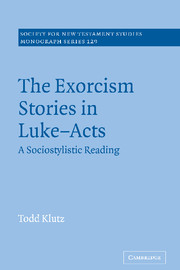Book contents
- Frontmatter
- Contents
- Acknowledgements
- List of abbreviations
- Introduction
- 1 Sociostylistics and the exorcism in Luke 4.33–37
- 2 Purity and the exorcism in Luke 8.26–39
- 3 Discipleship and the exorcism in Luke 9.37–43a
- 4 Paul, Jewish identity, and the exorcism in Acts 16.16–18
- Conclusion
- Bibliography
- Index of sources discussed
- Index of names and subjects
3 - Discipleship and the exorcism in Luke 9.37–43a
Published online by Cambridge University Press: 22 September 2009
- Frontmatter
- Contents
- Acknowledgements
- List of abbreviations
- Introduction
- 1 Sociostylistics and the exorcism in Luke 4.33–37
- 2 Purity and the exorcism in Luke 8.26–39
- 3 Discipleship and the exorcism in Luke 9.37–43a
- 4 Paul, Jewish identity, and the exorcism in Acts 16.16–18
- Conclusion
- Bibliography
- Index of sources discussed
- Index of names and subjects
Summary
Like the tradition of the Gerasene demoniac, the story of Jesus' encounter with a man and his demonically afflicted son is found in all three Synoptics (Matt. 17.14–21; Mark 9.14–29; Luke 9.37–43a). In all three the man discloses that some of Jesus' disciples had already proved themselves incapable of correcting the boy's condition; in all three Jesus responds with a lament over the faithlessness of his generation; and in all three Jesus himself ultimately succeeds against the demon and liberates the boy. Not without reason, therefore, the three accounts are normally read by scholars of the Gospels as variant renderings of a single unit of tradition.
Yet, like many other units in the triple tradition, this one has been shaped into three markedly different performances. Indeed, as detailed at several points below, the particular configuration of agreements and disagreements between the three accounts is sufficiently tangled to cause serious headaches for anyone bent on having a tidy solution to the Synoptic problem. Even more than the stories analysed in the last two chapters, therefore, Luke 9.37–43a welcomes a reading that is released from the bonds of the source-critical yoke. By taking full advantage of the methodological jubilee, and more specifically by shifting critical focus away from the elusive interaction between tradition and redaction to the interplay between story and co-text, the reading below has implications that ripple powerfully throughout the remainder of this study, impacting my understanding of everything from the structure of Luke 9.1–50 as a whole and the relative prominence of exorcism in it to the macrostructural function of the story in Acts 16.16–18 and the implied situation of all four Lucan narratives of exorcism.
- Type
- Chapter
- Information
- The Exorcism Stories in Luke-ActsA Sociostylistic Reading, pp. 152 - 206Publisher: Cambridge University PressPrint publication year: 2004



